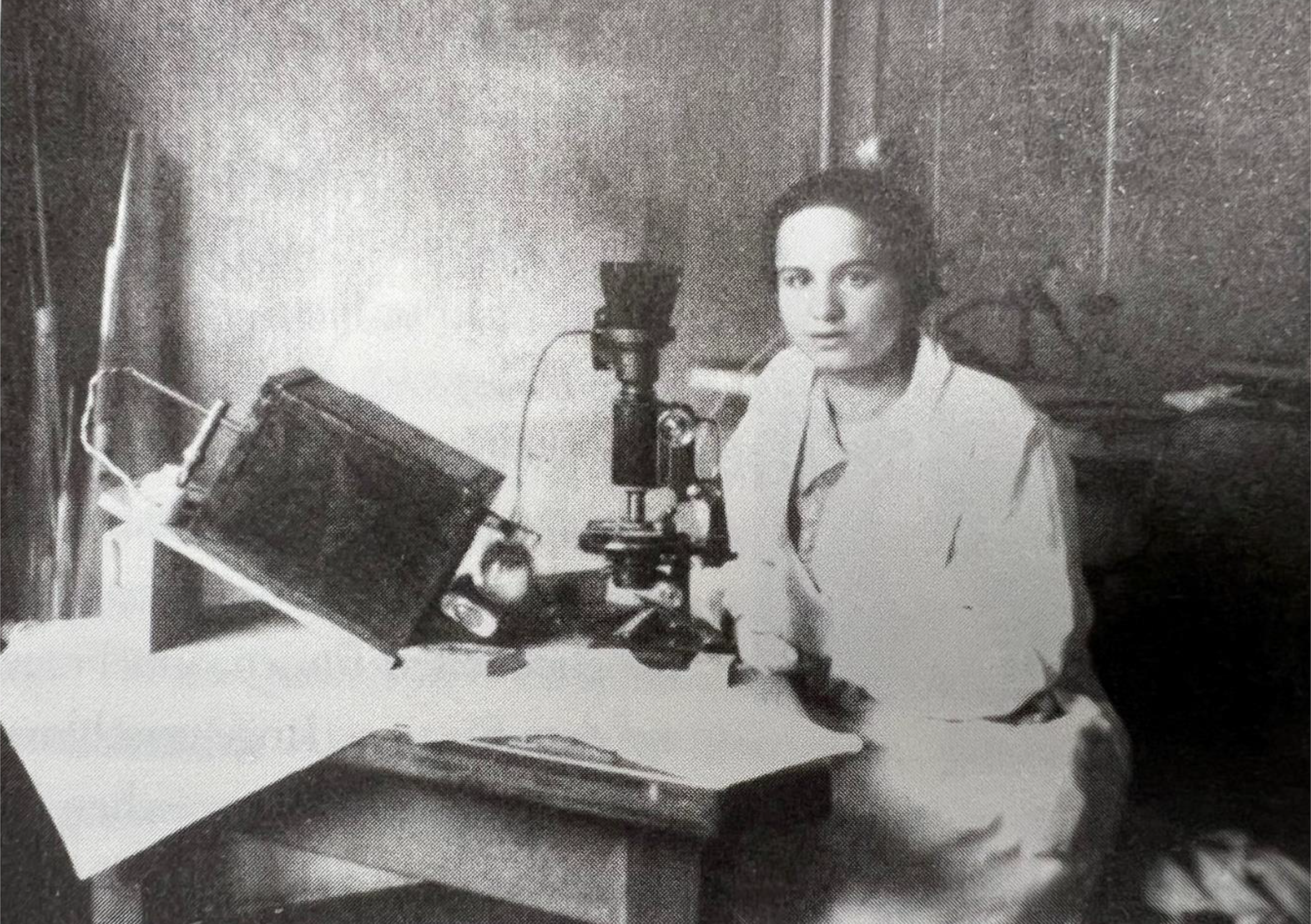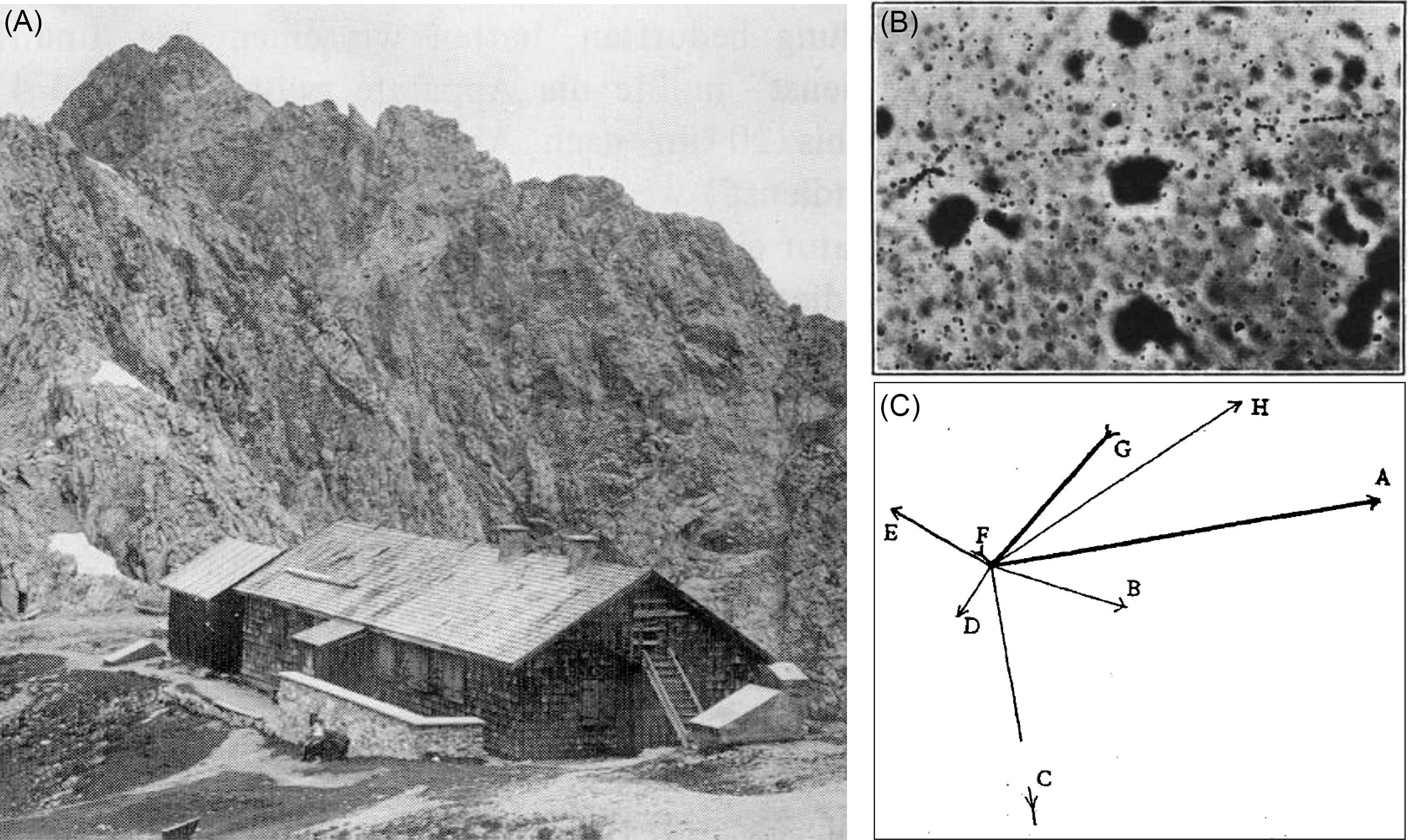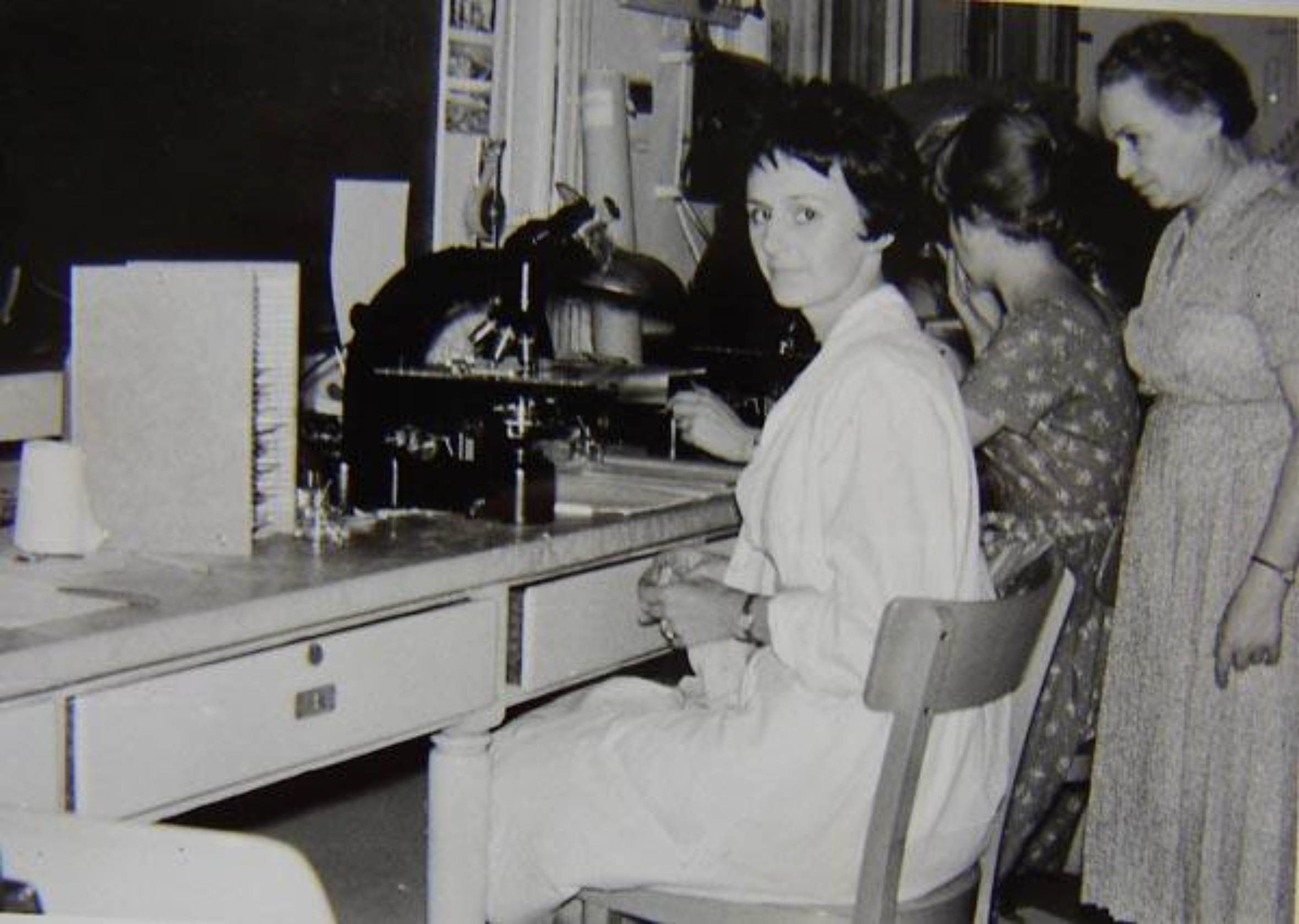The Vienna Radium Institute and the Discovery of Cosmic Rays
It is well known that atmospheric production of 14C on Earth occurs by thermal neutron capture on 14N via the nuclear reaction 14N(n,p)14C initiated by the secondary cosmic-ray neutron flux, and Libby (Reference Libby1946) estimated the equilibrium content of 14C in carbon on Earth which is in exchange with atmospheric carbon. This knowledge led to the development of the radiocarbon dating method (Arnold and Libby Reference Arnold and Libby1949; Libby et al. Reference Libby, Anderson and Arnold1949). The discovery of cosmic rays occurred much earlier (Hess Reference Hess1912; Kolhörster Reference Kolhörster1914), guided by the search for the origin of ionization of the atmosphere. Measurements by Theodor Wulf at the Eiffel tower had been inconclusive (Wulf Reference Wulf1910). Victor Franz Hess (1883–1964) undertook a series of balloon flights up to 5300 m measuring an increase of the ionization of air with altitude (Hess Reference Hess1912). At that time, Hess held the position of First Assistant at the Institute for Radium Research of the Imperial Academy of Sciences in Vienna. This institute, called in short Vienna Radium Institute (VRI), had been founded in 1910 through a generous donation (equivalent in today’s terms of ∼3 million Euros) to the Academy of Sciences by Karl Kupelwieser, a wealthy court lawyer.
Hess explained the detected increase of ionization with altitude as being caused by a penetrating radiation from “above”. His observations were confirmed by Werner Kolhörster in Germany who eventually reached 9300 m in his balloon flights (Kolhörster Reference Kolhörster1914). The discovery of cosmic radiation was followed by a variety of cosmic-ray investigations during the first half of the 20th century (Strohmaier Reference Strohmaier2023a). Even though Robert Millikan was critical about the discoveries of Hess and Kolhörster for a number of years (see the historical account of Walter and Wolfendale Reference Walter and Wolfendale2012), Victor Franz Hess received the 1936 Nobel Prize in Physics for the discovery of cosmic rays, together with Carl David Anderson who discovered the positron as a by-product of cosmic-ray interaction with matter (Anderson Reference Anderson1933).
Marietta Blau and the Photographic Method of Particle Detection
Here we concentrate on the role which Marietta Blau (Figure 1) played in the checkered history of cosmic ray discoveries. Almost forgotten as an early researcher in particle physics, her valuable contribution was acclaimed only towards the end of the 20th century (Galison Reference Galison1997). Her biography was published in extended form (Rosner and Strohmaier Reference Rosner and Strohmaier2003; Strohmaier and Rosner Reference Strohmaier and Rosner2006a, Reference Strohmaier and Rosner2006b) as well as in summarizing articles (Sime Reference Sime2013; Strohmaier Reference Strohmaier2023b).

Figure 1 Marietta Blau (Courtesy Eva Connors).
Marietta Blau (1894–1970) worked at the VRI from 1923 to 1938 (Figure 2). Her research work during this time concerned the application of photographic emulsions to detect tracks of charged particles, namely α-particles and protons, resulting from radioactive decay and nuclear reactions.

Figure 2 Marietta Blau at the Vienna Radium Institute in 1927 (Courtesy Agnes Rodhe).
Blau experimented with various types of photographic plates, the essential properties being grain size, i. e., average size of silver-bromide crystals in the emulsion, and the layer thickness of the emulsion. Conditions of the development procedures, in particular duration and temperature of development as well as composition and concentration of the developer, had to be adjusted to the features of the emulsion. The length of a particle track in the emulsion is a measure for the energy of the incident particle. In order to exploit this information, the track must be contained in the emulsion as a whole which requires that the particle passes the emulsion approximately parallel to its surface. Using an optical microscope, Blau traced thousands of tracks of α-particles and protons measuring track length and density of black silver grains in order to obtain statistical information which would enable particle discrimination and energy determination from track properties.
In an advanced stage of her work, Marietta Blau together with her colleague Hertha Wambacher exposed nuclear photographic emulsions for five months at the high-altitude cosmic-ray observatory (2265 m asl) near Innsbruck in 1937. This facility had been established by Victor Hess when he was a Professor of Physics at the University of Innsbruck from 1931 to 1937. After developing the exposed emulsions, Blau and Wambacher discovered multiple tracks of charged particles radiating outwards from single central points (Figure 3).

Figure 3 The discovery of the disintegration stars. (A) Cosmic-ray observatory at the Hafelekar (2265 m asl) near Innsbruck, now an EPS historical site. (B) Photographic plate showing 8 tracks of heavy particles and (C) corresponding sketch of these tracks, reproduced from Blau and Wambacher (Reference Blau and Wambacher1937a).
The tracks were termed “multiple disintegration” and interpreted to be those of fragments resulting from the breakup of the heavy nuclei (Br, Ag) of the emulsion by high-energy cosmic-ray interaction. Due to the starlike shape of these tracks they were called “disintegration stars” (Blau and Wambacher Reference Blau and Wambacher1937a). From the analysis of four of 60 registered stars, Blau and Wambacher estimated the total kinetic energy of emitted particles to be several hundreds of MeV (Blau and Wambacher Reference Blau and Wambacher1937b).
Shortly thereafter, Erwin Schopper from the Technische Hochschule in Stuttgart exposed nuclear emulsions in Stuttgart and at the Jungfraujoch (3464 m asl) in Switzerland, and found evidence for reactions with secondary neutrons from cosmic rays (Schopper Reference Schopper1937). Later he continued exposures of nuclear emulsions in unmanned balloon flights up to 18,000 m asl (Schopper and Schopper Reference Schopper and Schopper1939). Tracks similar to those registered by Blau and Wambacher (Reference Blau and Wambacher1937a, Reference Blau and Wambacher1937b) were observed, confirming their earlier finding. Nuclear emulsions were also exposed at the Jungfraujoch and at sea level by a group from England (Heitler et al. Reference Heitler, Powell and Fertel1939), who found tracks from disintegration stars just like the ones observed by Blau and Wambacher (Reference Blau and Wambacher1937a, Reference Blau and Wambacher1937b).
Marietta Blau in Exile 1938–1960
Marietta Blau left Vienna in March 1938 for a research visit to the University of Oslo on the invitation from Ellen Gleditsch who was a pioneering woman radiochemist in Norway. The next day after Blau had left Vienna, the “Anschluss” of Austria to the German Reich took place, which left her stranded in Norway. While in Oslo, Blau continued her research analyzing photographic emulsion plates exposed for five months at the Jungfraujoch (Blau Reference Blau1938). Because of her Jewish ancestry she did not return to Vienna, but thanks to Albert Einstein’s previous intervention found a position at the National Polytechnic Institute (IPN) in Mexico City. Although this saved her life, she was not able to continue her research in cosmic-ray physics.
After a five-year stay in Mexico City, Marietta Blau moved to the USA in 1944. She first gained employment in industry, namely with the research department of the International Rare Metals Refinery Inc. and later with the Canadian Radium and Uranium Corporation. In 1948, the U.S. Atomic Energy Commission employed her as a research scientist at Columbia University, and two years later, after she had obtained U.S. citizenship, she moved to Brookhaven National Laboratory (BNL). This allowed her to use the powerful Cosmotron accelerator with a maximum proton energy of 3.3 GeV to continue her research on high-energy proton-induced reactions using nuclear emulsions (Blau et al. Reference Blau, Rudin and Lindenbaum1950, Reference Blau, Caulton and Smith1953; Blau and Caulton Reference Blau and Caulton1954). In 1956 she accepted a position as associate professor at the University of Miami, continuing her research with experiments at BNL (Blau and Oliver Reference Blau and Oliver1956, Blau Reference Blau1956, Blau et al. Reference Blau, Carter and Perlmutter1963).
In 1950, Erwin Schrödinger proposed Blau and Wambacher for the Nobel Prize in Physics, pointing out how important their method was in exploring cosmic rays in general and that, in particular they had been the first to interpret the stars correctly as nuclear disintegrations induced by cosmic rays. In the late 1950s, Schrödinger nominated Blau for the Nobel Prize in Physics again, as had been done in 1955 by the Viennese physicist Hans Thirring. She was never awarded the Nobel Prize.
Marietta Blau returned to her home town Vienna in 1960, where she worked again at the Vienna Radium Institute, supervising the analysis of photographic plates from CERN experiments (Figure 4).

Figure 4 Marietta Blau (right) watching students scanning photographic plates at the Vienna Radium Institute in the 1960s. On the left is Lore Eggstain. (Archive R. & L. Sexl).
The Use of the Nuclear Emulsion Technique at Bristol
Marietta Blau’s early expertise in using nuclear photographic emulsions for cosmic ray studies was made known to Cecil Powell by Walter Heitler (Frank and Perkins Reference Frank and Perkins1971). After the Second World War, Cecil Powell and his group at the University of Bristol performed numerous analyses of cosmic-ray interactions in nuclear emulsions exposed at the Pic du Midi observatory (2800 m asl) in the Pyrenees (Occhialini and Powell Reference Occhialini and Powell1947a, Reference Occhialini and Powell1947b), which led to the discovery of the pion (Lattes et al. Reference Lattes, Muirhead, Occhialini and Powell1947). As the leader of the Bristol cosmic-ray group, Powell received the 1950 Nobel Prize of Physics “for his development of the photographic method of studying nuclear processes and his discoveries regarding mesons made with this method.” Although Marietta Blau was the first to pioneer and develop methods for using nuclear emulsions to study nuclear disintegrations by cosmic-ray interaction (Blau and Wambacher Reference Blau and Wambacher1937a), she was not rewarded for her discoveries other than receiving the Erwin Schrödinger Prize in 1962 from the Austrian Academy of Sciences. A similar absence of rightful recognition befell Viennese Jewish scientist Lise Meitner, who discovered nuclear fission together with Otto Hahn, but was not included in the 1944 Nobel Prize in Chemistry by Otto Hahn “for his discovery of the fission of heavy nuclei”, nor was she considered for a Nobel Prize in Physics (Crawford et al. Reference Crawford, Sime and Walker1997).
Radiocarbon Dating at the Vienna Radium Institute
Under the VRI directorship of Berta Karlik (1904–1990), Heinz Felber set up a facility for low-level β-radioactivity measurements in the early 1960s (Felber and Vychytil Reference Felber and Vychytil1961), suitable for radiocarbon dating. It was based on converting carbon into methane, using it as a counter gas in a proportional counter with internal anticoincidence counter ring and 20 cm iron shielding to detect the feeble decays of 14C (Felber Reference Felber1970; Strohmaier Reference Strohmaier2023a). Together with Edwin Pak (Figure 5), who succeeded Felber after his retirement in 1987, radiocarbon decay counting measurements on many different materials were performed (e.g., Felber and Pak Reference Felber and Pak1973). This classical β-counting method was continued by Edwin Pak until 2004, after which radiocarbon dating was solely performed with the modern method of Accelerator Mass Spectrometry (AMS).

Figure 5 Heinz Felber left (1922–2013), 1986 (Courtesy Edwin Pak), and Edwin Pak (b. 1943), ∼2010 (Photo by Walter Kutschera), who performed classical radiocarbon dating at the Vienna Radium Institute.
The Vienna Environmental Research Accelerator (VERA)
In 1996, a new AMS facility based on a 3-MV Pelletron tandem accelerator was commissioned at the VRI (Kutschera et al. Reference Kutschera, Collon, Friedmann, Golser, Hille, Priller, Rom, Steier, Tagesen, Wallner, Wild and Winkler1997). It quickly developed into an AMS facility to measure many long-lived radionuclides at ultra-low abundances (Golser and Kutschera Reference Golser and Kutschera2017). Figure 6 shows the current configuration of VERA.

Figure 6 Schematic layout of the Vienna Environmental Research Accelerator in 2023, including the recent addition of Ion Laser Interaction Mass Spectrometry ILIAMS (Martschini et al. Reference Martschini, Lachner, Hain, Kern, Marchhart, Pitters, Priller, Steier, Wiederin, Wieser and Golser2022).
Conclusion
Cosmic rays were discovered about 110 years ago, and their study spans a wide range of fields from astrophysics to radiocarbon dating and accelerator mass spectrometry. Cosmic rays are messengers from space carrying important information about the origin of elements and producing a plethora of secondary nuclides through interaction with the atmosphere and the surface of the Earth. In this work we acknowledge the pivotal and central role played by Marietta Blau who worked at the Vienna Radium Institute and developed the technique of nuclear-emulsion photographic plates to detect high-energy cosmic rays by their interaction leading to “disintegration stars”.
Today, the technique of accelerator mass spectrometry allows one to measure ultra-low abundances of many cosmogenically produced long-lived radionuclides resulting from cosmic-ray interactions in the atmosphere and on Earth’s surface, opening up a wide range of research opportunities (Kutschera et al. Reference Kutschera, Jull, Paul and Wallner2023).
Acknowledgment
Helpful comments on the manuscript by David Fink from ANSTO are gratefully acknowledged.









